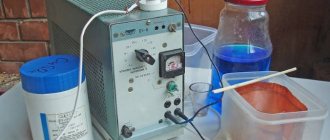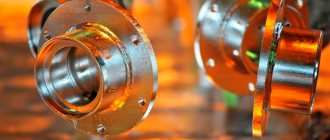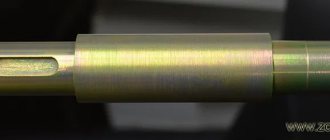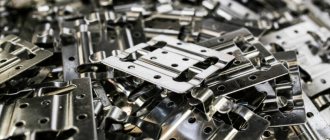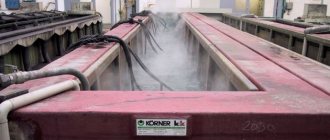Electroplating as a technology for processing metal products is an electrochemical process, the participants of which are the workpiece, an electrolyte, two electrodes and an electric current. An electrolyte is a conductive liquid substance from which, as a result of the passage of an electric current through it, metal molecules are released, deposited on the surface of the workpiece and forming a thin film on it. Galvanic coatings, which is what makes them remarkable, are formed not by simply applying a layer of metal to the surface being treated, but as a result of the penetration of its molecules into the surface layer of the part.
Electroplating is a reliable way to obtain a protective or decorative coating on metal products
Purpose of the galvanic method
Electroplating of metal on the surface is used to give them the properties of a specific material (silver, gold, nickel, etc.). Or if it is impossible to make an item from this material, and also if the price is unreasonably high.
For example, the application of chromium imparts hardness and anti-corrosion properties to plain steel. This technology was widely used to coat parts and mechanisms of machine tools. Chrome, in addition to being hard, gives a mirror-like shine and provides good protection against corrosion. Chrome is a hard but brittle metal, and it is not possible to manufacture parts and objects from it. Applying it to the surface by electroplating is a good alternative, as well as the opportunity to use the properties of chromium in everyday life.
The galvanizing process is carried out in special baths. An electrolyte containing salts of the metal that is deposited on the surface of the workpiece is poured into it. Compared to other methods, electroplating technology has advantages. When using, for example, a spray gun or other spraying devices (many organizations pass off this method of metallization as electroplating), it is impossible to achieve a perfectly even coating, high-quality adhesion and obtain the properties of metal on the surface. Usually, a non-conductive polymer layer is applied by spraying, in other words, paint, or a thin silver layer (for the reaction of a silver mirror, see the school curriculum), and on top is a transparent or colored varnish. The electroplating process makes it possible to obtain a uniform, dense, well-adhesive coating that has all the properties of the deposited metal.
Electroplating Shop Harmful to Humans
Coating of metals by electrodeposition
from aqueous solutions of metal salts occupies one of the prominent places among metal coatings. Electrodeposition processes are carried out in devices called electrolyzers or galvanic baths. An aqueous solution of acidic salts (nickel sulfate, zinc sulfate, copper sulfate) or alkaline complex salts (cyanide compounds of copper, zinc, cadmium, silver, gold) of metals poured into baths is called an electrolyte. Electric current is introduced into the electrolyte through carbon or metal electrodes, usually in the form of rods or plates.
Even small concentrations of chromic anhydride
in the air can cause more or less significant damage to the nasal mucosa. Gasoline, chlorinated hydrocarbons and kerosene used to degrease products can also have an effect on the skin. Cases of hydrogen cyanide poisoning in galvanic shops, both acute and chronic, are observed extremely rarely - when acidic solutions of salts and cyanide alkaline electrolytes are accidentally spilled on the floor and mixed, if the acid and alkaline baths are located adjacent and do not have separate drains within the workshop for electrolytes that fall on the floor.
The consequences that you read about in the previous paragraph do not necessarily appear if you follow preventive measures and organize production correctly. Firstly, it is necessary that the premises in which the workshops are located should, if possible, be one-story. All rooms must be as isolated as possible, and they must have a good ventilation system, which is especially important in production that pollutes the air. In addition, the workshop structure must be planned in such a way that the equipment makes up no more than 20% of its premises. It is necessary to have passages and passages so as not to create obstacles during the work process.
It is no secret that working in a galvanic shop is associated with health hazards. That is why the state provides social guarantees for workshop workers. For example, for workers dealing with chrome and copper plating of shafts, state pensions are provided on preferential terms and in preferential amounts.
Passages in tunnels and galleries must be separated from busbars by metal mesh with holes no larger than 20x20 mm. The width of the passage should be 1.0 m between the wall and the fence with one-sided tires and 1.2 m between two fences with two-sided tires.
We recommend reading: If After Painting You Don’t Change Your Last Name You Need to Change Your Passport
Immersion of parts into baths and removal from them must be done under stress-free conditions. Products should be lowered into the solution and removed from it only with tongs or on hangers smoothly, avoiding splashing of the electrolyte. Small items are immersed in the solution in steel wire baskets.
The essence of the technological process
Electroplating is used to produce thick technical and thin decorative layers of metal. The functions of electroplating are determined not by the layer that is applied to the surface, but by its characteristics: thickness, sublayer, preparation (etching, polishing).
The electroplating method is quite simple:
- The workpiece is carefully inspected for existing coatings and surface condition.
- Procedures for degreasing, etching and activating the surface of the part are carried out.
- The composition of the liquid electrolyte in which the product will be immersed is selected.
- Electrolyte is poured into a special bath to which one or two anodes are connected.
- A part connected to the cathode is lowered into it.
- An electric current is started.
- Under its influence, particles of metal salts are directed towards a negatively charged product.
- Metal is deposited on the entire surface of the product in a thin, uniform layer.
- After completion of the galvanic process, the supply of electric current is stopped, the product is removed, thoroughly washed and dried, and, if necessary, further processed.
Electroplating technology is simple, but requires special equipment and sufficient qualifications of performers.
The galvanic method is used to give mechanisms, contact groups or surfaces the properties of the applied metal. For example, the application of precious metals (gold, palladium, rhodium) to electrical contacts is used to impart chemical resistance, as well as maintain constant resistance. In this case, the species characteristics are not important. Of course, it is necessary to maintain the specified grain size of the coating, but this problem appears at metal deposit thicknesses of more than 20 microns. Thick galvanization gives high wear resistance and non-porous metals, which means the reaction properties of the base material can be ignored.
Technical Nickel electroplating coatings are made for units and items that experience constant mechanical stress. Nickel is a hard, inexpensive metal. It is applied to steel products that require corrosion protection.
Often there are lubricant coatings, the application of which does not so much take into account the chemical characteristics of the metal itself as it is necessary to ensure, for example, tight lapping of parts, but for some reason lubricants cannot be used. These are tin, lead, indium coatings. In these cases, the coating thickness ranges from 30 to 50 microns.
Our organization, 6 Micron LLC, provides services for the application of technical coatings to defense enterprises, enterprises in the space and aviation industries, and the electronics industry.
There are often cases when metals are applied only for decorative purposes or to add color (gold, silver, etc.), without requests for hardness or density.
Galvanic method
The galvanic coating method is used in the following industries:
- Treatment of products against corrosion;
- Coating of parts and assemblies of complex machines and equipment;
- Processing of costume jewelry and jewelry;
- Ensuring solderability and wettability of the surface of parts;
- Giving antioxidant and decorative properties to the surface (mainly precious coatings).
While large industrial electroplating baths are required in the field of mechanical engineering, automotive industry, and metal structures production, compact equipment is used in the production and electroplating of jewelry and contact groups.
Jewelry companies make up the number of regular clients of our organization. The production of jewelry from precious metals and jewelry alloys periodically requires the application of a protective or decorative layer of electroplating to the surface. For example, jewelry alloys coated with a layer of real gold increase in price several times, while the cost of jewelry is relatively low. Owners of big names often take advantage of this, releasing collections of jewelry in gold or rhodium plated, despite the fact that the price of plated earrings is often comparable to the price of earrings made of pure gold.
The requirements for electrolytes and the result of processing at a jewelry factory are very high: it is necessary to maintain the class of the surface, the shade of the applied metal, and the thickness of its application. Typically, for jewelry and decorative purposes, the application thickness does not exceed 2 micrometers, so the listed requirements are feasible.
In the field of applying decorative coatings to jewelry, 6 Micron LLC cooperates with factories from the Moscow region, St. Petersburg, Kostroma, Kaliningrad region, as well as other constituent entities of the Russian Federation.
Our organization has a broad area of activity - electroplating on souvenirs, gifts, and household items. Giving a souvenir plated with gold or silver, electroplating an antique watch, restoring it on antique dishes - all these are our daily services. For example, a builder is given a gold helmet as a gift, and a hockey player is given a gold puck. The list of ideas here is limited only by human imagination. Any item can be treated with galvanic gold to get an original souvenir or memorable gift. Gilding is performed only with 999 purity gold. Electroplating is the only way to apply real gold or silver.
Also, clients turn to us in order to obtain a beautiful chemical-resistant coating for plumbing fixtures - faucets, buttons, levers, valves.
Over the past 5 years, electroplating has also often been used for gilding jewelry made from real wood leaves, flowers, and twigs. Recently, this idea has become popular and requests for such work are coming in more and more often.
Environmental problems of electroplating production
Heavy metal ions are zinc, nickel, chromium, copper, tin, lead... and a good part of the entire periodic table. And they merge because sooner or later the coating electrolytes fail, and their volumes and replacement frequency are significant. Of course, it’s easier to pour everything into the nearest reservoir or bury it in the forest if we are talking about 50 liters or 10 kg per year. But what if it’s tens of cubic meters per week or tons per month? How aware are we of this (we should mention here our right to know the extent of the harm and receive compensation for it)? As a result, we have hundreds of tons of toxic waste. How are they harmful? Most ITMs are carcinogenic, meaning that they cause cancer. They accumulate in the body and leave it very slowly. Chromium, for example, can be absorbed even through the skin and exhibits carcinogenic effects in extremely low concentrations. Here we note that hexavalent chromium is the most harmful - the main component of chromium plating electrolytes, as well as zinc passivation.
We recommend reading: Where to Get an Extract from the House Register If You Are Registered in Boltino, Mytishchi
Ways of ITM entering the human body. On the issue of waste treatment. Until now, the most common method of recycling galvanic waste is the reagent method. Its essence is that all waste is converted into a solid, slightly soluble state by treatment with special reagents. Then tons of such waste are buried in special landfills. There are not enough such landfills in the Urals. And it’s quite logical to ask, where does the waste go? Even many directors of enterprises where this waste is generated do not know the answer to this question. And dislocating them in public landfills is perhaps the best thing to do with them. But even if the waste is buried correctly, this does not mean that it is neutralized. So, although the buried compounds (mainly hydroxides) are poorly soluble, a certain part of them still enters drinking water sources with rain, melt, and groundwater, and from there into our body. Or these compounds accumulate in the plants that livestock eat or in the water they drink. Then ITM accumulate in meat, milk, and animal fat and joyfully arrive on our table, continuing their expansion. As mentioned earlier, the human body leaves ITM with great reluctance.
Preliminary inspection of the part
Before starting work, the expert will conduct a preliminary examination, assessing the size, shape, geometry of the product, the presence of decorative elements, engraving, and relief details. The composition of the metal is also important.
Based on the information obtained, the composition of the electrolyte is selected. The exact thickness of the galvanic layer is agreed upon with the customer in advance. The thicker the coating, the longer it will last, the higher the processing costs and, therefore, the higher the cost of work.
If necessary, the metal is additionally degreased and cleaned. Polishing is only possible to a small extent and only on simple parts. If you need to get a mirror coating on a product, you need to first polish it at a jeweler or yourself. This is the only way to obtain a perfectly smooth galvanic coating. The integrity of the product is not compromised when applying galvanic coating. If the part is complex, then disassembly into individual parts is required before the galvanizing process.
Often, before the process of applying metal begins, it is necessary to carry out preliminary mechanical processing. This is necessary, since the applied metal completely preserves the structure of the surface that was before treatment. Therefore, if it is necessary to carry out a complete restoration of the surface, defects are specified in advance, we clarify what can be corrected and what will remain after treatment.
The thoroughness of mechanical surface treatment depends on the depth of defects (scratches, impacts, grinding, corrosion cavities, etc.). Mechanical processing (from coarse to fine processing):
- sandblasting;
- grinding;
- Kratsovka;
- polishing
After mechanical processing, they begin directly to apply the metal to the surface, that is, directly to electrochemistry. The technological map of the galvanic process is written depending on the source material and the finishing coating.
The sequence of actions and the time between baths are of great importance. The entire line of electroplating must be completed without long breaks.
What is a line
A galvanic line is a set of several devices that operate in one area. The main parameters for the design of such systems are their performance, as well as the dimensions of the product for which this line should be designed. The type of line will directly depend on how large the dimensions of the product will be and what its serialization will be. Galvanic lines can be of the screw type, they can be manual or manual with a telpher. Today, the automatic operator type of line, which has software control, is becoming very popular.
The line may also include auxiliary equipment. It is necessary in order to withstand the technological process, as well as ensure complete safety of work for people on the site.
Connecting electrodes
Electrodes are connected to the bath and the product to start an electric current. The positive terminal is connected to the anodes, and the workpiece is connected to the negative terminal. After starting the galvanic system, an electric current passes through the electrolyte, so metal cations stick to the surface of the negatively charged product. The metal contained in the electrolyte settles on the part in an even, uniform layer. Two anodes are used to treat the surface on both sides simultaneously. This is a very simplified but correct diagram of the galvanic process.
Equipment for work. Bath
These workshops have a variety of equipment, but the main one is a galvanic bath. This device is divided into two types. The first is called active, the second - auxiliary. They differ in that in the first types of baths the required coating is directly applied to the product. In the auxiliary equipment of the galvanic workshop, the stage of preparing the part for the further procedure takes place. The important thing to understand here is that auxiliary equipment is just as important as the main one. Among them are baths for washing, drying, and preparing the mixture.
Galvanic process
The system is run via a constant current source with adjustable input voltage or current levels. The longer the effect of electric current on the electrolyte and the product lasts, the thicker the protective coating layer becomes. Sometimes a part is processed several times, depending on the specific technology and the final task from the client.
The temperature of the electrolyte is important. Sometimes an additional heating device is used, which is immersed in the galvanic bath or located outside it.
Strict requirements are imposed on the room where processing takes place. A prerequisite is effective ventilation, running water and fire safety. The work takes place in laboratories that are specially equipped to perform such tasks. Optimal microclimatic conditions are created here, the required temperature and air humidity are maintained. Experts work in special protective suits. The technology of metal electroplating has been thoroughly studied by representatives of the research and production enterprise.
Bathtub design
The design of the baths in the galvanizing shop is quite simple and is a cube that has additional stiffeners, as well as some additional elements. Among such additional devices, for example, there is a heating element, a lid, filtration, a cooling system, a water supply and drainage system, cleaning systems, suspensions, anodes, etc.
For the production of such things, stainless steel, PVC, polypropylene, as well as other raw materials with similar characteristics can be used. However, at present, PVC and polypropylene are the most widely used, and steel and metal products have faded into the background. This is due to the fact that polymer materials are more resistant to aggressive chemicals and high temperatures.
Electroplating Process Stages
- chemical galvanic cleaningChemical cleaning is carried out to remove residues of polishing pastes, oils, grease from fingers, etc. The cleaning operation is carried out chemically or electrochemically. The choice of cleaning method depends mainly on the shape of the part. Simple shapes are processed under current, complex shapes with large internal cavities, holes and concave surfaces are processed chemically. The main indicator of properly carried out cleaning is complete wettability of the surface. Poor surface cleaning is the most significant error in galvanic processes.
- etchingThe etching procedure is carried out to improve adhesion to the metal surface. Etching is also carried out both chemically and electrochemically. The etching procedure is not used for mirror surfaces, since the surface class of the part after etching will be worse than it was initially. Electroplating in some cases compensates for etching, but this is the exception rather than the rule.
- application of sublayer galvanizing
Electroplating works according to strict laws and requires adherence to the application order. For example, copper and gold must be separated by a layer of nickel to avoid diffusion processes of gold into copper. In addition, these sublayers are required to increase the gloss of the surface itself, increase adhesion and increase the overall dimensions of the part.
The line of different sublayers often consists of a so-called classic galvanic cake, consisting, for example, of layers such as nickel-copper-nickel.
In many cases, this universal scheme requires adjustment and refinement.
In production, technological maps are written for each process individually, indicating operating modes, holding time and sequence of operations.
Obtaining new products requires the development of an individual technological map. This is the main difficulty of a small electroplating production - diverse products require daily work to set up the process.
Correcting errors in 90 percent of cases involves complete cleaning of poorly applied elements. Moreover, most often this has to be done mechanically; the chemical method of removal has limited use in electroplating.
- application of final galvanic coating The final application of metal is carried out only on a fully prepared, clean, non-oxidized exterior of the product. Electroplating in general and finishing coating in particular does not improve the class of mechanical processing. If, after applying all the preparatory coatings, the part does not look of high quality (not shiny, there are defects in the coating or the original surface), then there is no point in applying the finishing coating. Not taking this fact into account is one of the most common mistakes of a novice electroplater. The thickness of metal applied to the surface specified in the technical specifications (3 microns, 6 microns, 20 microns) refers specifically to the finishing coating. This is what ensures its durability. Sublayers can be of any thickness, if there are no strict requirements for them. Before applying the finishing galvanization, the product must be thoroughly washed to remove any remnants of sublayer elements (electrolytes). Washing is carried out with running hot and then cold water, and then additionally washed with distilled water. The latter is needed to prevent running water from getting into the electrolytes of precious metals, because chlorides, salts of heavy metals, and sulfates are destructive to silver and gold electrolyte. The accumulation of impurities in precious metals should not be allowed. Spoiled electrolytes are subject to long-term processing or disposal. At this stage, electroplating is completed, but additional refinement is often required.
- related operations. Sometimes the finishing coating is the last stage of the galvanic process, but often this is not the case. Example: after applying the finishing electroplating silvering, mandatory brushing of the surface is required. This is done manually, or “tumbling drums” are used. If such post-processing is provided, silver (or other metal) is applied 2-5 microns more than initially required, and possible losses are taken into account. Polishing post-processing is rarely used, since this removes a significant layer of the applied metal. That is why, to obtain a smooth surface, preliminary polishing and preparation is required before all galvanic operations.
Types of auxiliary installations
Electroplating equipment used at sites must prepare raw materials and components for further work. For this purpose, for example, there are two filter units. One of them is stationary, the other is mobile.
If we talk about the first type of installation, then the UFE-1S model is usually used. It is intended for filtering either water or electrolyte from any mechanical impurities. An additional feature of the stationary type is that it can be connected to an airless mixing system, which has a solution filtration function.
A mobile type filter is usually represented by the UV 2400 model. It can be used, like a stationary one, to filter electrolyte or water from mechanical contaminants. Their difference is that this pump can also pump this water or other aggressive chemicals.
Liquid demineralization devices are also used. The unit is presented in the form of an UVD-500 installation, which is capable of removing salt from a liquid so that it fully complies with a state standard such as 6709-97. This water is used to prepare a new electrolyte, as well as for any washing operations carried out in the workshop.
There is also smaller-scale equipment, for example, conventional pumps, but with increased resistance to chemicals in order to successfully pump electrolyte. Equipment is used for drying products.
Galvanic technologies
In electroplating, the electroplating method is widely used. In this case, the product immersed in a galvanic bath acts as a negative, that is, the coating does not grow on the working side of the product, but on the back, reverse side. A layer of metal is deposited onto a mold made of non-conductive material, most often copper. The thickness of copper can reach 2 mm; usually such a strength margin is not required and, on average, coatings up to 1 mm are grown in electroplating. After separating the matrix from the created layer, its exact copy is obtained. In this way, exact copies of salaries, medals, panels, and decorative elements are created.
Ventilation
Ventilation of a galvanizing shop is one of the most important occupational safety requirements. This is very important, since during the galvanic process, that is, the coating of products, harmful vapors are released into the air, which are dangerous not only for humans, but also for the room where they are released. Because of this, when designing a workshop, special attention is paid to ventilation equipment and ventilation in general.
For this type of workshop, it is allowed to use ventilation pipes made of polypropylene. This is due to the fact that this material belongs to the group of non-flammable ones, is moisture-proof, resistant to chemical influences, and is also very easy to install both on the ceiling, floor or walls.
Result evaluation
Upon completion of processing, experts evaluate the final result. If galvanizing work is carried out by professionals, there is no need to doubt the high quality of the coating. Using precision instruments, the thickness of the applied metal layer, uniformity of the coating, and other criteria are assessed.
Individuals or legal entities can contact us regarding galvanization. Any client idea will be submitted to our technologists for consideration!
Technologists at 6 Micron LLC have extensive experience in the field of electroplating and preparatory stages. Coating can be applied either according to a strict specification or according to a simple verbal description. Electroplating is our specialty!
Gordienko Anastasia Vadimovna Author of the materials Position: chief technologist of 6 Micron LLC Education: higher Experience in galvanizing: 13 years
When placing an order online, get a 10% discount!
Our priority is an individual approach to each order and the quality of the work performed!
Send a request or ask a question:
4.2/5 — (526 votes)
The profession of galvanizer refers to work in difficult conditions.
By Resolution of the Cabinet of Ministers of the USSR No. 10 of January 26, 1991, List No. 2 of industries, jobs, professions, positions and indicators with harmful and difficult working conditions was approved, on the basis of which a pension is assigned in connection with special working conditions.
11/10/1960 b. I have 40 years of insurance experience, of which 4 years worked as a galvanizer and 1 year as a train compiler on the railway (harmful work is 5 years, i.e. less than half of 12 years and 6 months). He served in the army as a conscript in 1978-80. He was conscripted from the factory. When can I retire?


